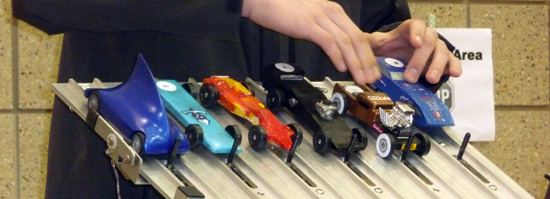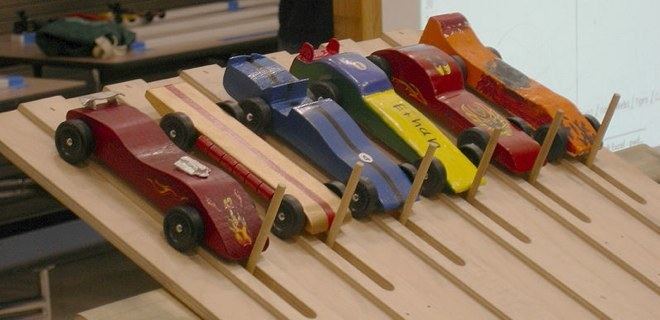Dates Annual | Country United States | |
 | ||
Easy pinewood derby car wins using science
The pinewood derby is a racing event for Cub Scouts in the Boy Scouts of America. Cub Scouts, with the help of parents, build their own cars from wood, usually from kits containing a block of pine, plastic wheels, and metal axles. With the popularity of the pinewood derby, other organizations have developed similar events, and a small industry has developed to provide tracks, timers, scales, trophies, ribbons, and other products. Similar Cub Scouting events include the raingutter regatta with boats and the space derby using rubber band-powered rockets.
Contents
- Easy pinewood derby car wins using science
- How to build the fastest pinewood derby car part 1
- Origins
- Construction
- Competition
- Other races
- Car modifications
- Legacy
- References

How to build the fastest pinewood derby car part 1
Origins

The first pinewood derby was held on May 15, 1953 at the Scout House in Manhattan Beach, California by Cub Scout Pack 280C (the present Pack 713). The concept was created by the Pack's Cubmaster Don Murphy, and sponsored by the Management Club at North American Aviation.

Murphy's son was too young to participate in the popular Soap Box Derby races, so he came up with the idea of racing miniature wood cars. The cars had the same gravity-powered concept as the full-size Soap Box Derby cars, but were much smaller and easier to build.
The pinewood derby had a sensational first year. Murphy and the Management Club of North American Aviation sent out thousands of brochures to anyone who requested more information. The idea spread rapidly, and competitions were held across the country, mainly with recreation departments and nonprofit organizations including the Los Angeles County Department of Recreation. Of all that early enthusiasm, however, only the Boy Scouts of America made it part of an official program. The National Director of Cub Scouting Service, O. W. (Bud) Bennett, wrote Murphy: "We believe you have an excellent idea, and we are most anxious to make your material available to the Cub Scouts of America." Within the year, the Boy Scouts of America adopted the pinewood derby for use in all Cub Scout packs.
In its October 1954 issue, Boys' Life publicized the event and offered plans for the track and a car, which featured "four wheels, four nails, and three blocks of wood."
Murphy continued to run the derby program through the Management Club until his retirement from North American Aviation in 1978. He died in 2008.
In 2003, Pack 713 celebrated the 50th Pinewood Derby along with Packs 287, 759, 275, and former Cub Scouts from the 1953 Pack 280c. A shoulder patch for the Western Los Angeles County Council that depicted a pinewood derby car and a message of honor to Murphy was released to celebrate the 50th anniversary of the event.
In 1980, the design of the block was changed from a cutout block, consistent with a 1940s style front-engined Indy 500 car, to a solid block. The tires were also changed from narrow, hard plastic, to wider "slicks."
In May 2005, the Boy Scouts of America registered Pinewood Derby as an official trademark.
Construction
The Scout is given a block of wood made of pine, four plastic wheels, and four nails. The finished car must use all nine pieces, must not exceed a certain weight (usually five ounces (150 grams)), must not exceed a certain width (usually 2-3/4 inches (7 cm)) and length (usually 7 inches (17.8 cm)) and must fit on the track used by that particular scout pack.
Blocks can be whittled with a hand knife, bandsaw, or Dremel carving tool for major shaping. Decals can be bought at scout shops or hobby shops. It is also possible to use standard model decals to replicate actual racing cars such as Richard Petty's 1970 Plymouth Superbird. The original style is based on open-wheel cars; however, fender or body kits are available, or wheels can simply be placed outboard of the body.
Other than the previous basic design rules, the Cub Scout is able to carve and decorate the car as he chooses. Many Cub Scouts also add weights to the final design to bring the car to the maximum allowable weight; coins and glued-in lead or steel pieces are common ways to add weight. Cars typically vary from unfinished blocks to whimsical objects, to accurate replicas of actual cars. Graphite is usually the only lubricant allowed, and it often helps to polish the provided nails.
The idea behind the pinewood derby is for the parent, usually the father, but sometimes the mother or grandparent, to spend time helping the child design, carve, paint, add weights, and tune the final car. However, it is often the case that the parent takes over the construction of the car, an aspect of the event that was lampooned in the 2005 film Down and Derby, and also in a 2009 episode of South Park. The quest for a fast car supports a cottage industry that supplies modified wheels, axles, and blocks as well as videos and instruction books. While a pinewood derby car kit costs around US$4, a set of modified wheels and axles can sell for more than ten times that amount. Each pack sets its own rules under the guidelines set forth by the BSA and their particular local district. The aftermarket items are legal under some Pack rules since the parts originally came from an official Boy Scouts of America (BSA) kit. Complete cars can be purchased on eBay and elsewhere for around $100 to $200. Although these cars violate the spirit of the event, if not the rules, enforcement can be difficult.
Model manufacturer Revell was licensed by the BSA to produce pinewood derby kits with a release in December 2009.
Competition
The track usually has two to six lanes and slopes down to the ground, since the cars are powered by gravity. Tracks may be owned by the pack or rented. The race is run in heats, giving every car the chance to run on each lane. The racers can be grouped with others from the same rank (Tiger Cubs, Wolf Cubs, Bear Cubs, etc.), or can compete against the pack as a whole.
First, second, and third-place winners usually receive ribbons, medals, or trophies. Some packs also award on the basis of car design or styling. The first place race winners get to advance to the district level, then each of the district-wide race winners get to race each other from across the entire council.
Other races
As the popularity of the pinewood derby grew, other organizations adopted the concept. Pinewood derby is a registered trademark of the BSA, so most use different names. Each derby has slightly different rules for making and racing their cars.
Car modifications
The force accelerating a pinewood derby car is gravity; the opposing forces are friction and air drag. Therefore, car modifications are aimed at maximizing the potential energy in the car design and minimizing the air drag and the friction that occurs when the wheel spins on the axle, contacts the axle head or car body, or contacts the track guide rail. Friction due to air drag is a minor, although not insignificant, factor. The wheel tread can be sanded or turned on a lathe and the inner surface of the hub can be tapered to minimize the contact area between the hub and body. Polishing the wheel, especially the inner hub, with a plastic polish can also reduce friction. Often one front wheel is raised slightly so that it does not contact the track and add to the rolling resistance. Axles are filed or turned on a lathe to remove the burr and crimp marks and polished smooth. More extensive modifications involve tapering the axle head and cutting a notch to minimize the wheel-to-axle contact area. Packs can establish additional rules for what, if any, modifications are allowed. In some areas, no changes can be made to the axles or wheels.
A second consideration is the rotational energy stored in the wheels. The pinewood derby car converts gravitational potential energy into translational kinetic energy (speed) plus rotational energy. Heavier wheels have a greater moment of inertia and their spinning takes away energy that would otherwise contribute to the speed of the car. A standard wheel has a mass of 2.6 g, but this can be reduced to as little as 1 g by removing material from the inside of the wheel. A raised wheel can reduce the rotational energy up to one-quarter, but this advantage is less with a bumpy track.
Another consideration is the track itself. A track that is mostly sloping, with little flat at the end, can allow cars with minimal mass in their wheels to shine. However, a track with a steep slope and then a long flat section can penalize such cars due to the quick loss of energy they experience once they have reached the bottom, when all potential energy has been transferred to kinetic and rotational energy. Such cars will take a lead on the downslope, but may be passed by cars with more energy "stored" away as rotational energy on the flat.
A proper lubricant, typically graphite powder, is essential. Wheel alignment is important both to minimize wheel contact with the axle head and body as well as to limit the contact between the wheels and guide rail as the car travels down the track. There are 32 friction causing surfaces on a pinewood derby car. These include the surfaces of all four wheels which touch either the axle, the body or the track and the surfaces of all four axles which touch the wheel. Neglecting to polish and lubricate any of these 32 surfaces will result in degraded performance. The center of mass of a typical car is low and slightly ahead of the rear axle, which helps the car track straight as well as providing a slight advantage due to the additional gravitational potential energy.
Legacy
The pinewood derby was selected as part of "America's 100 Best" in 2006 as "a celebrated rite of spring" by Reader's Digest. The event has also been parodied by South Park in the episode "Pinewood Derby" and in the film Down and Derby.
